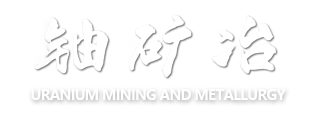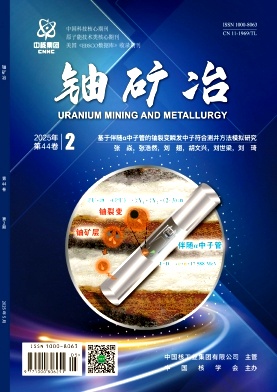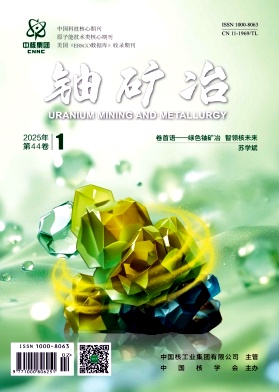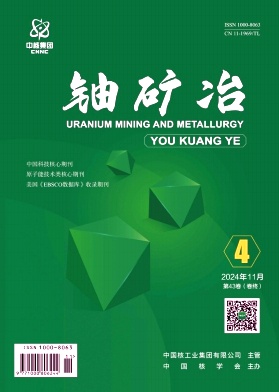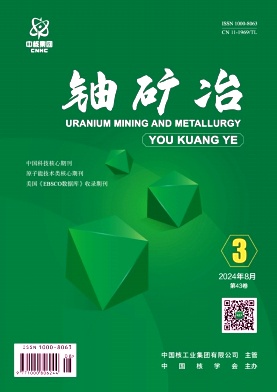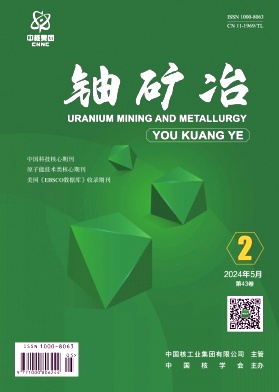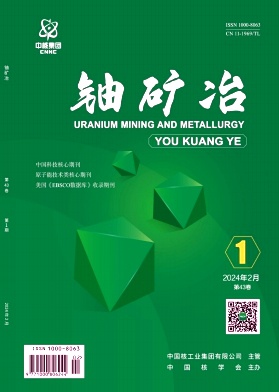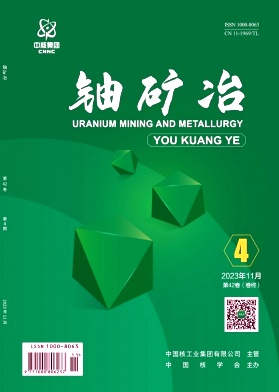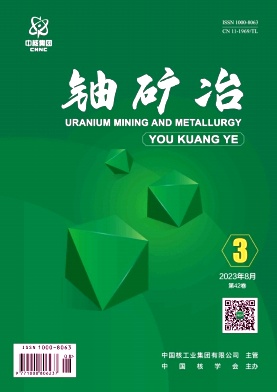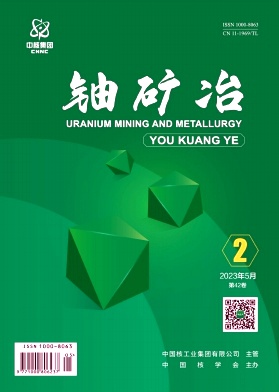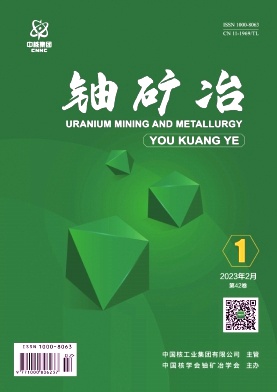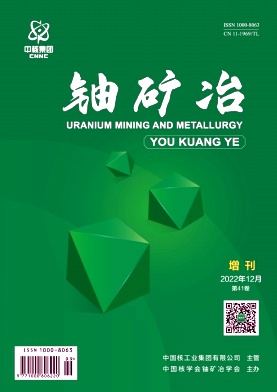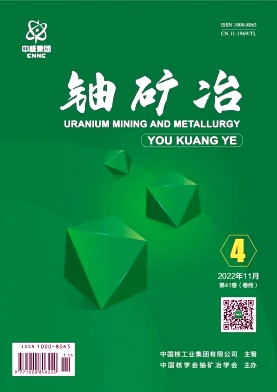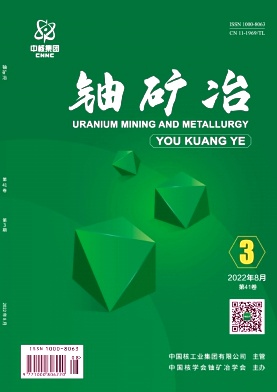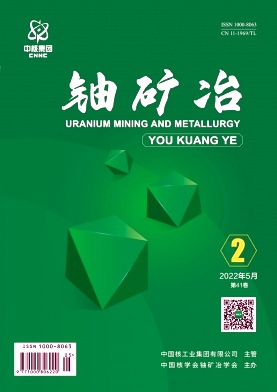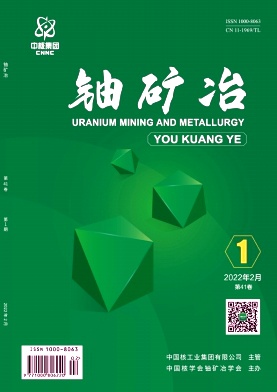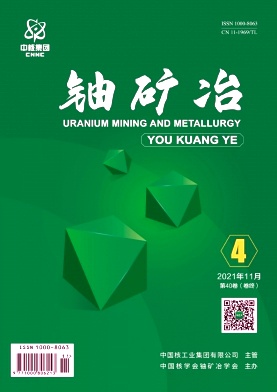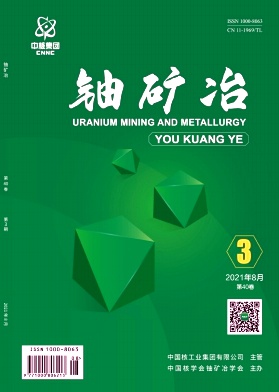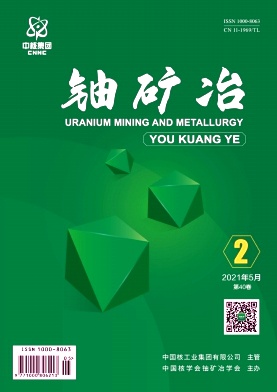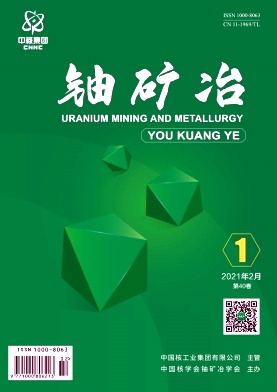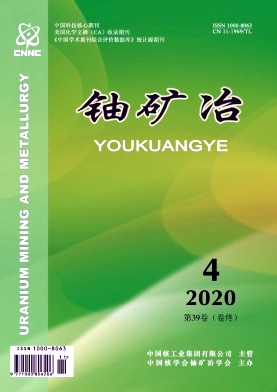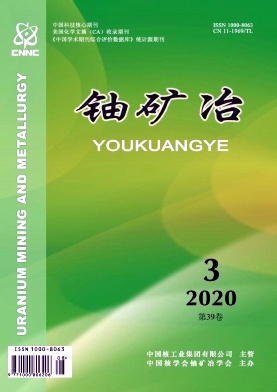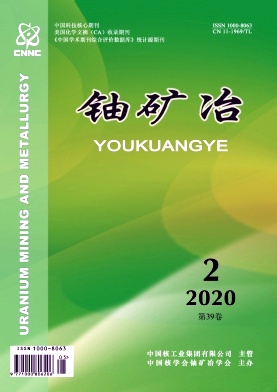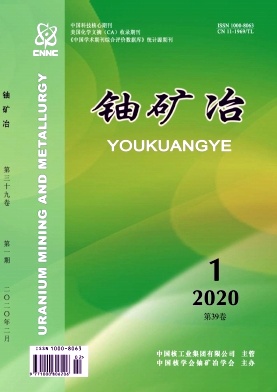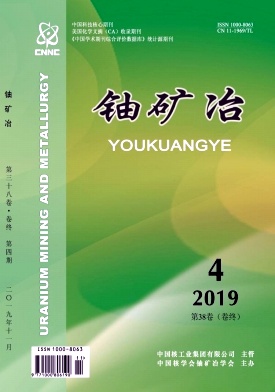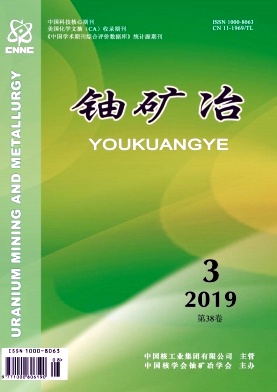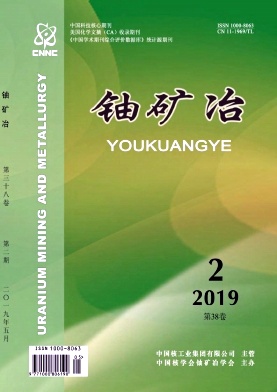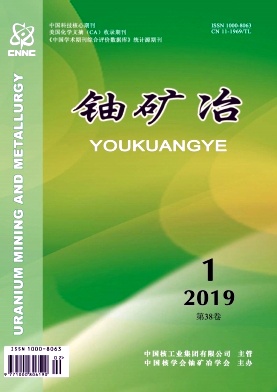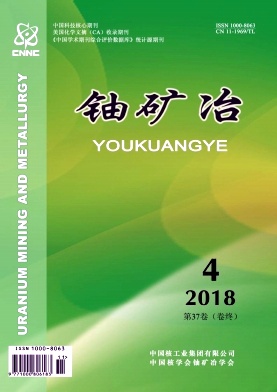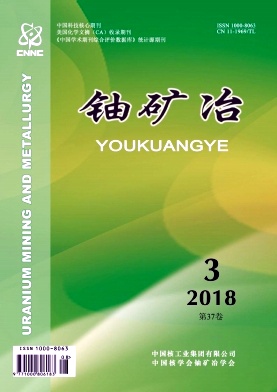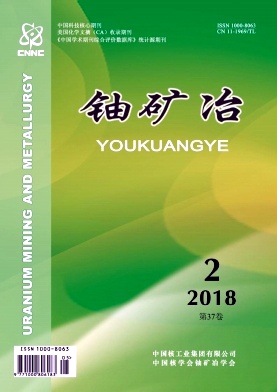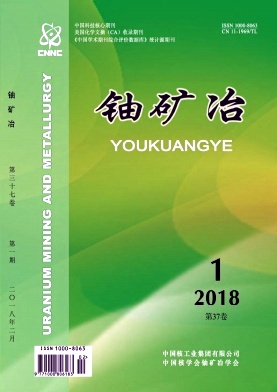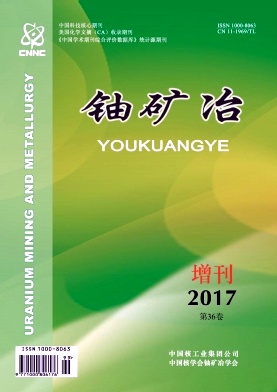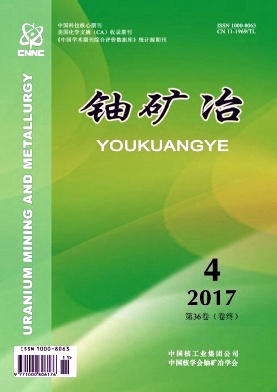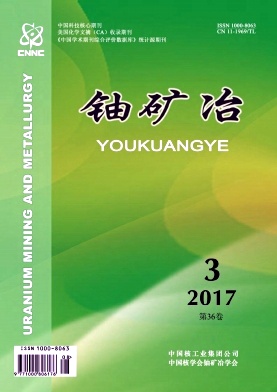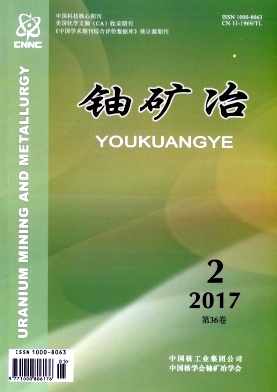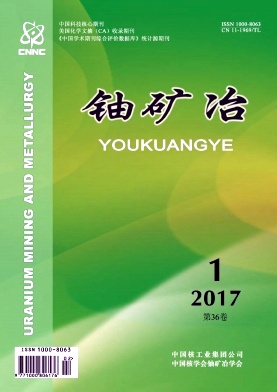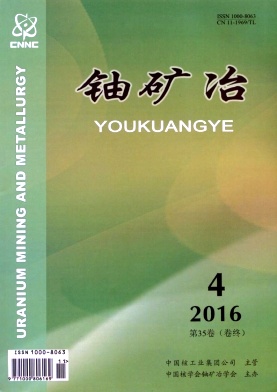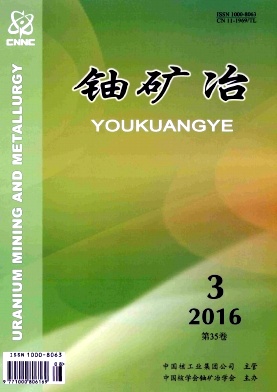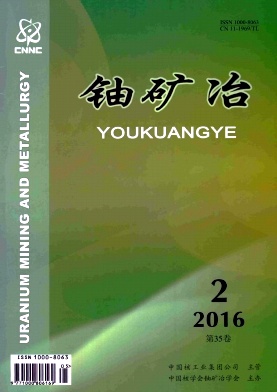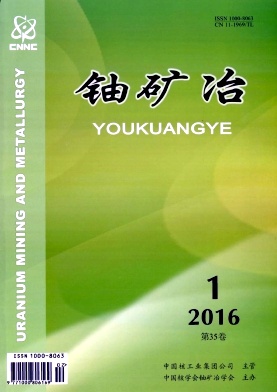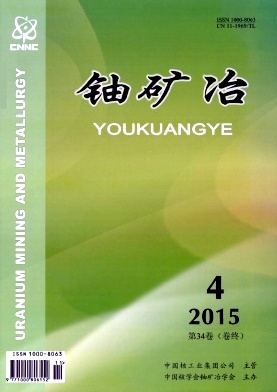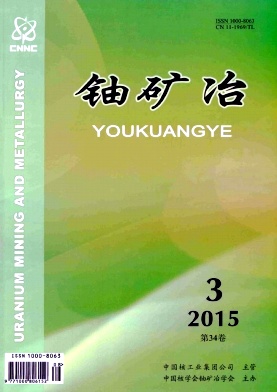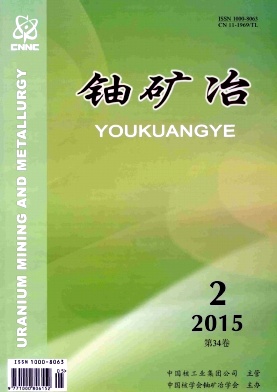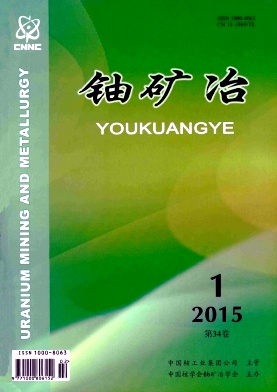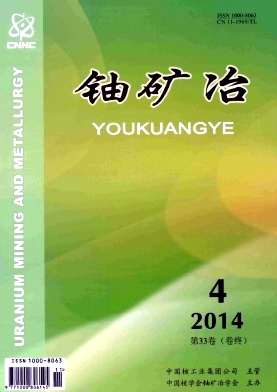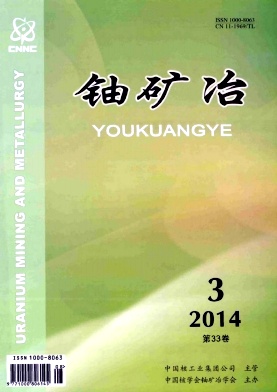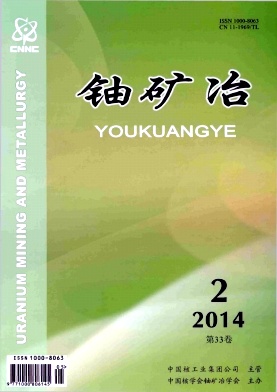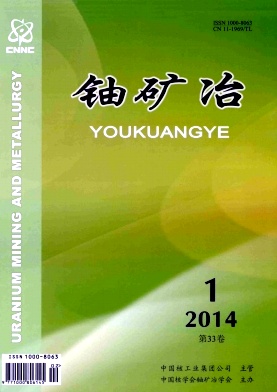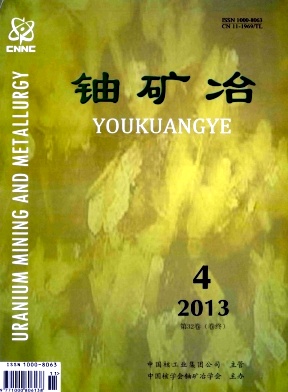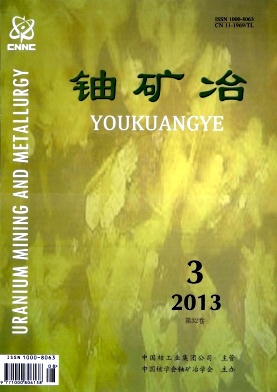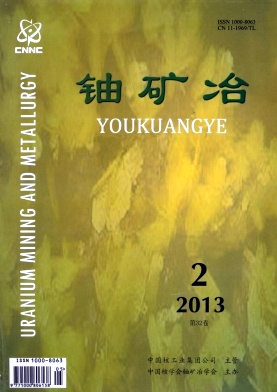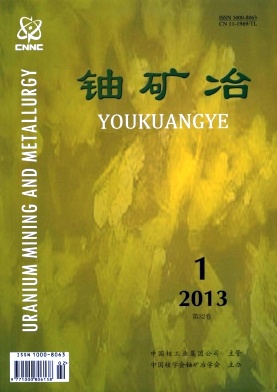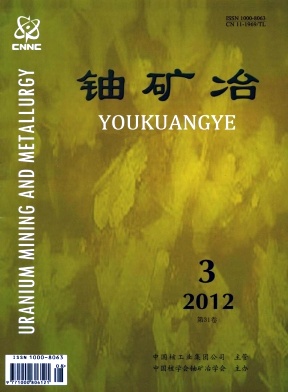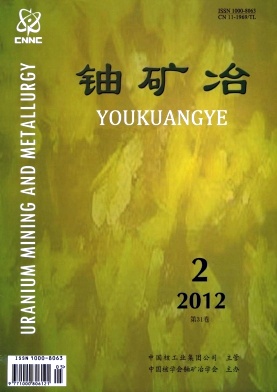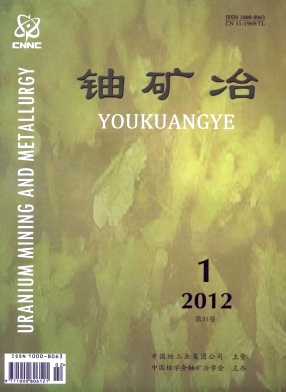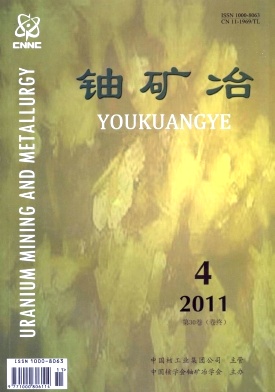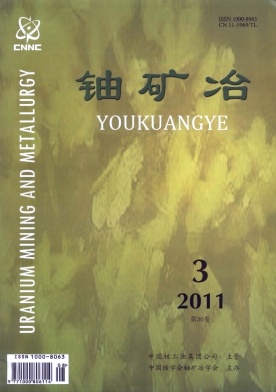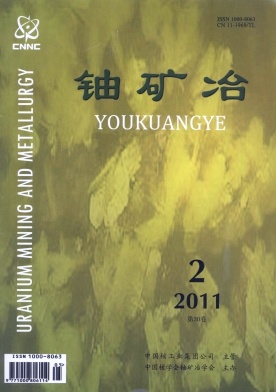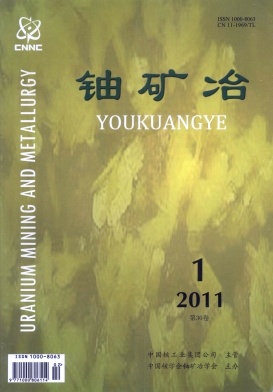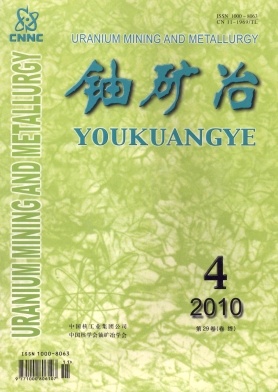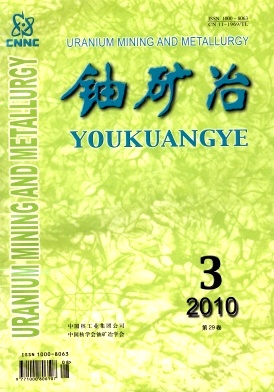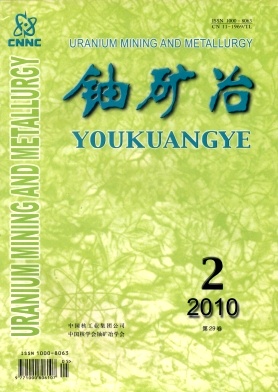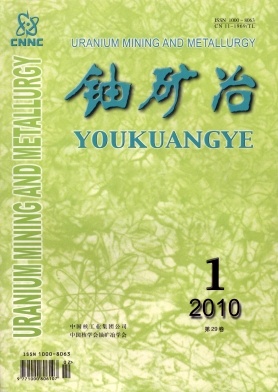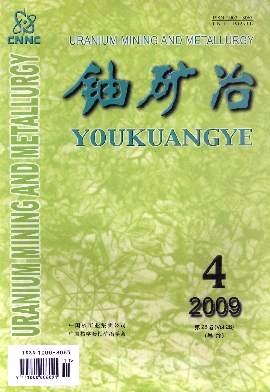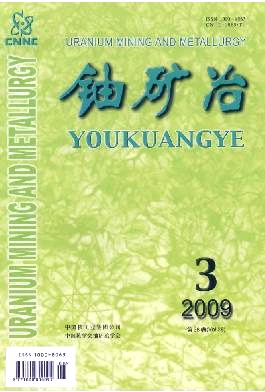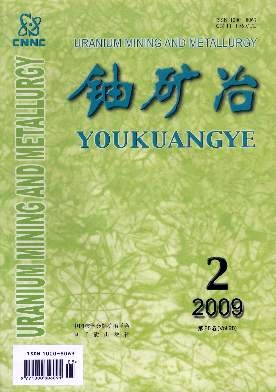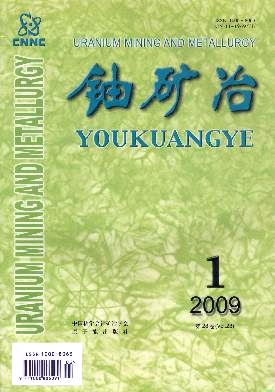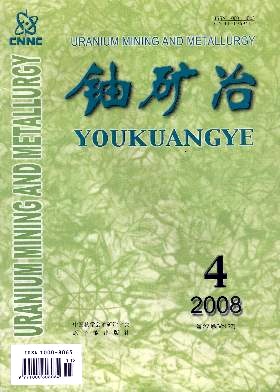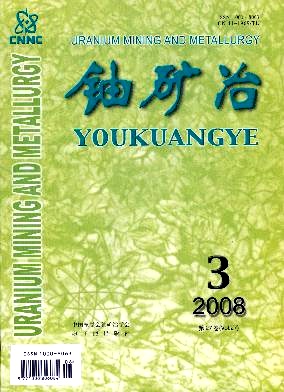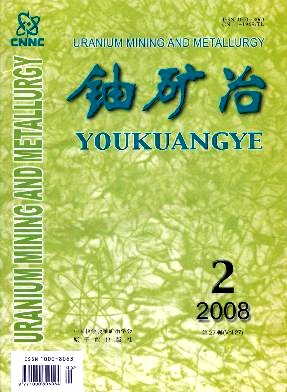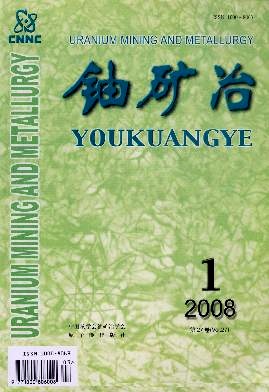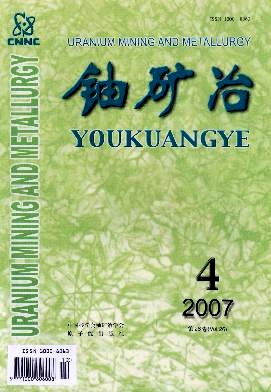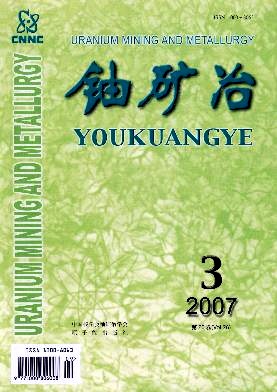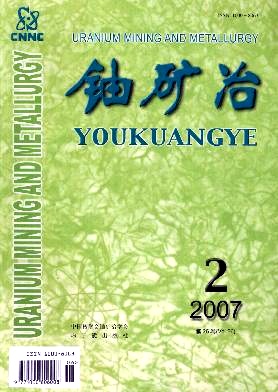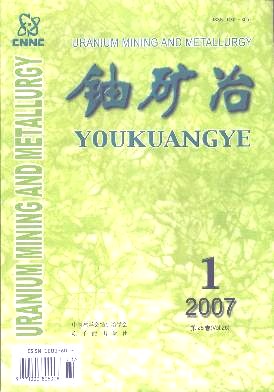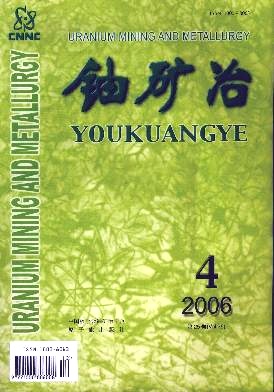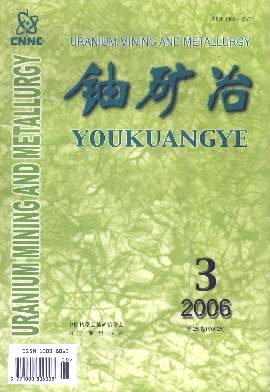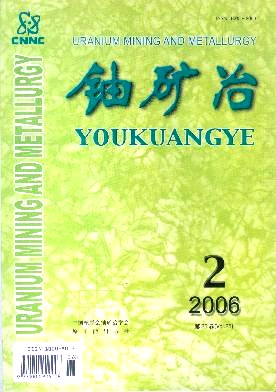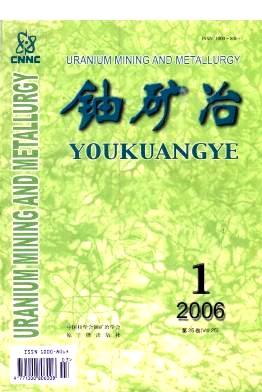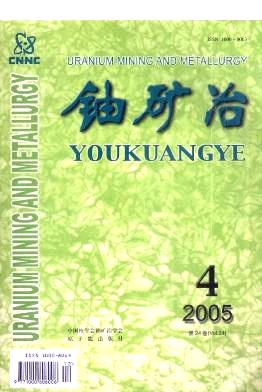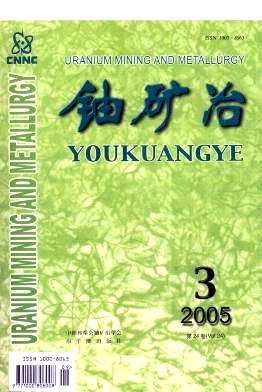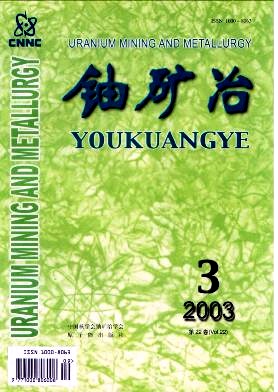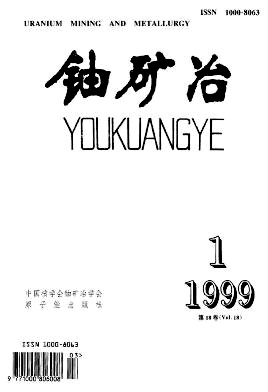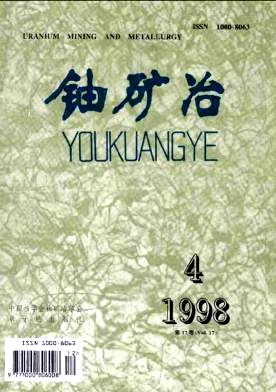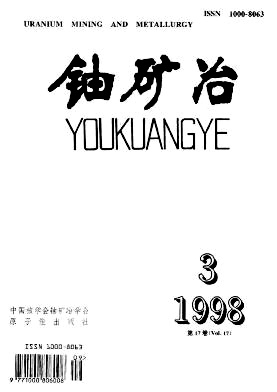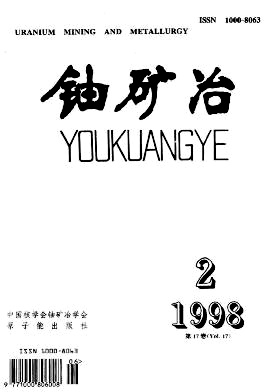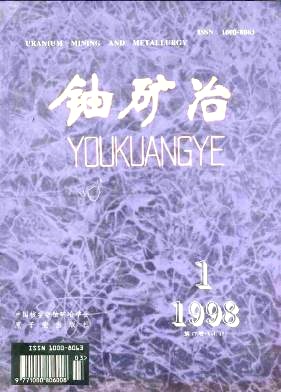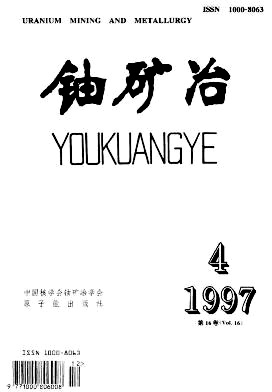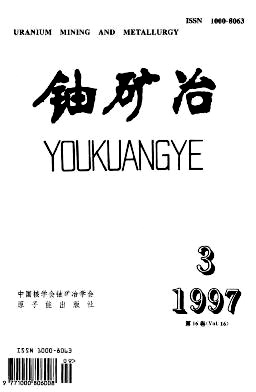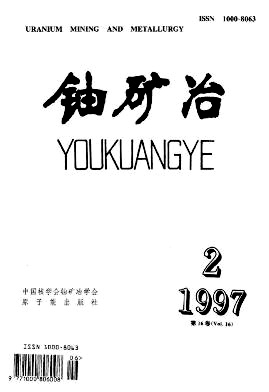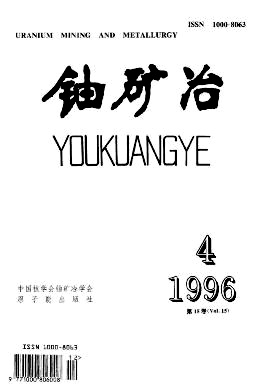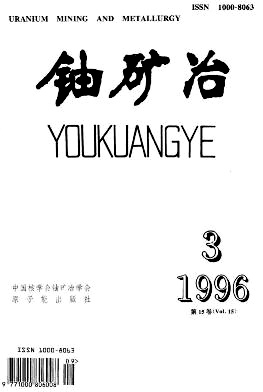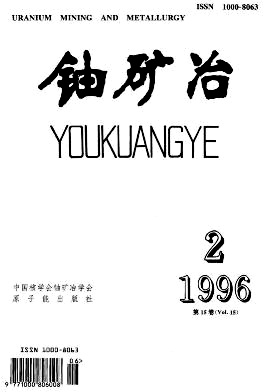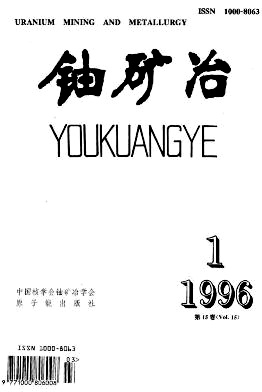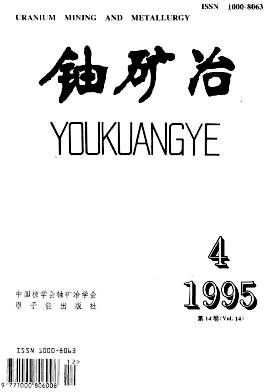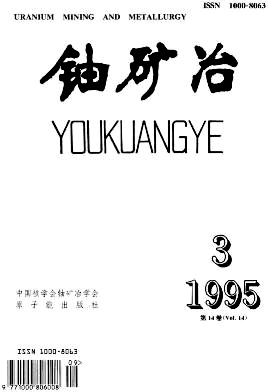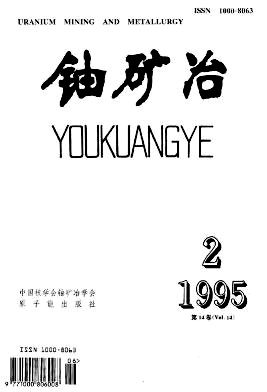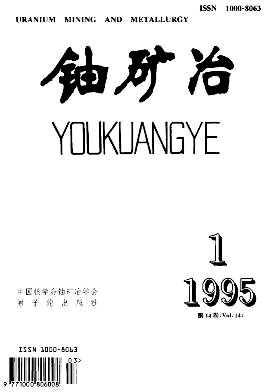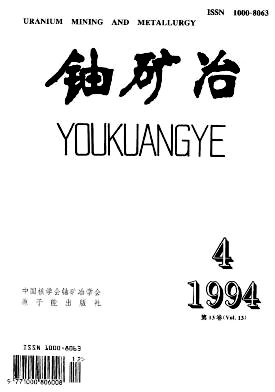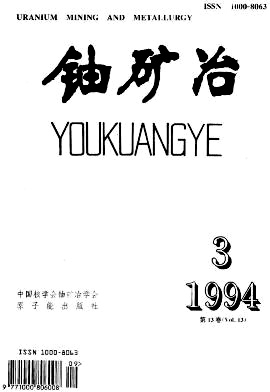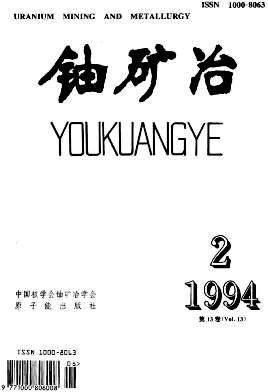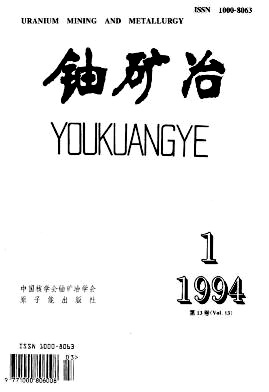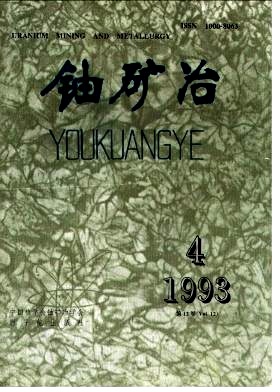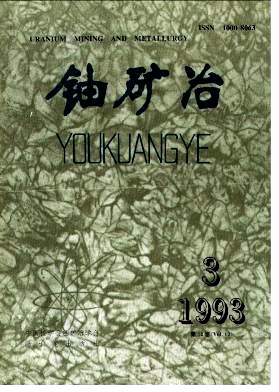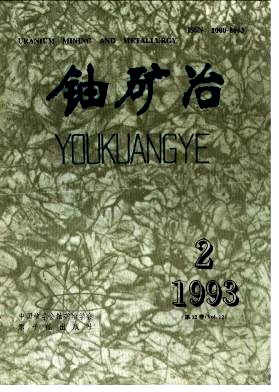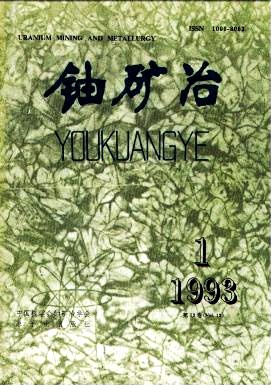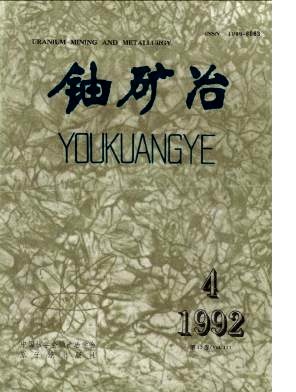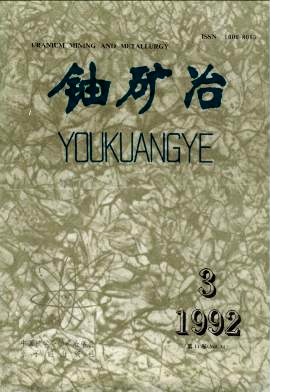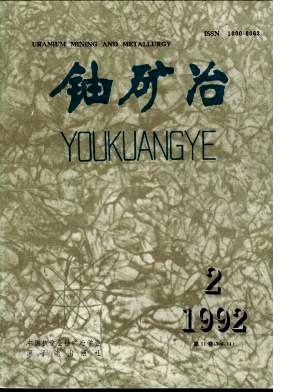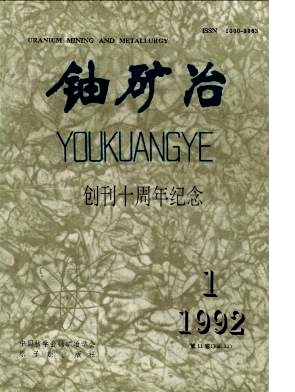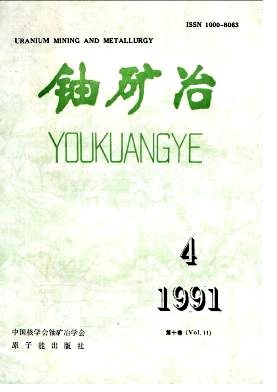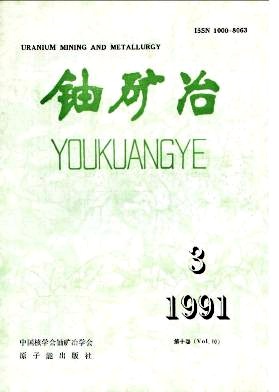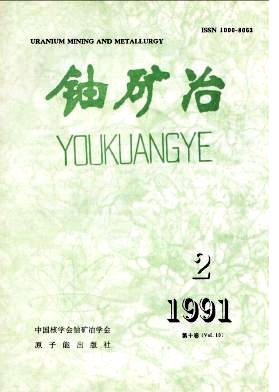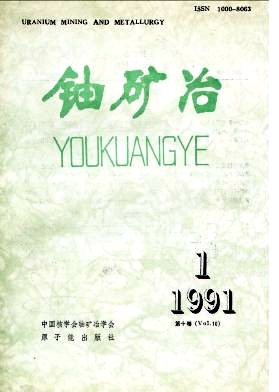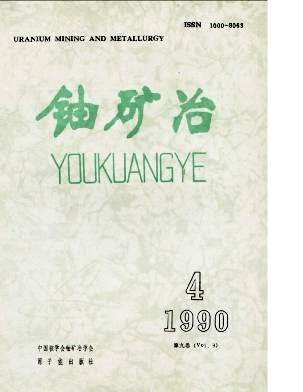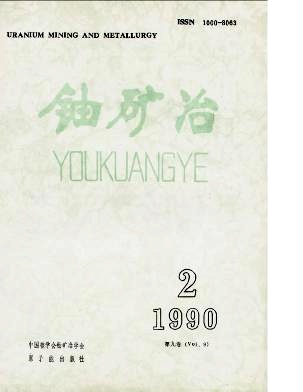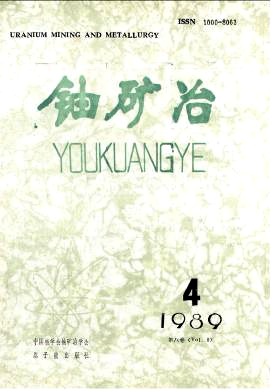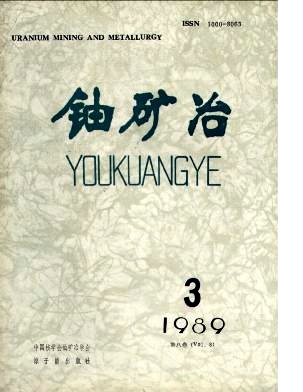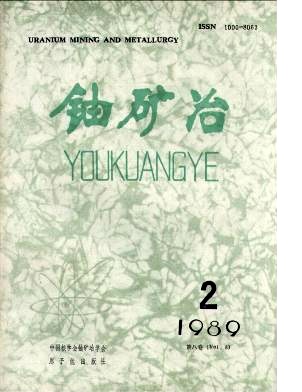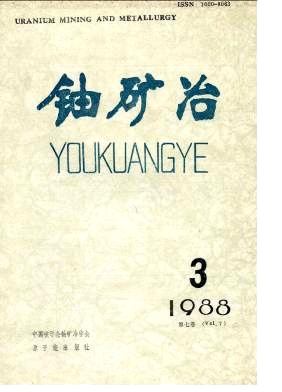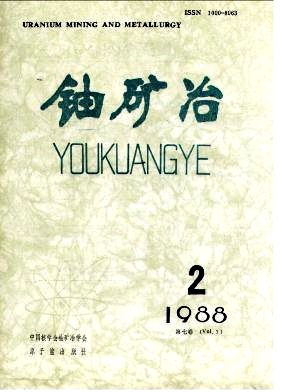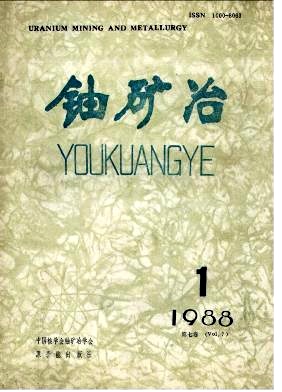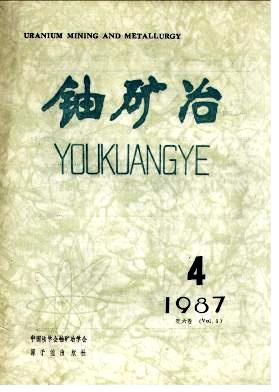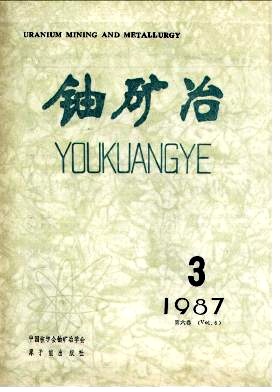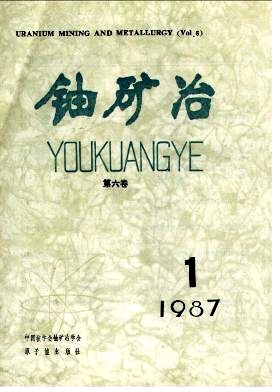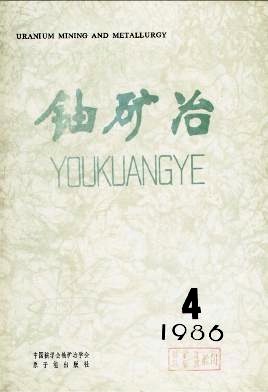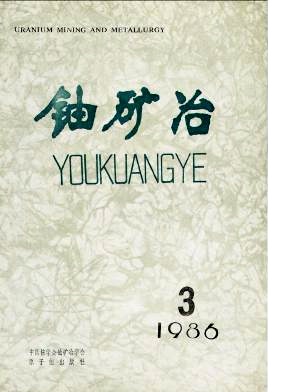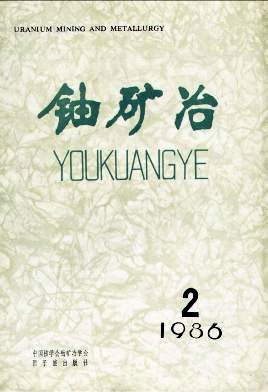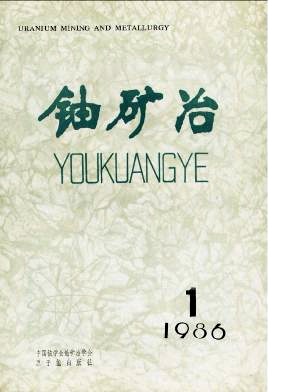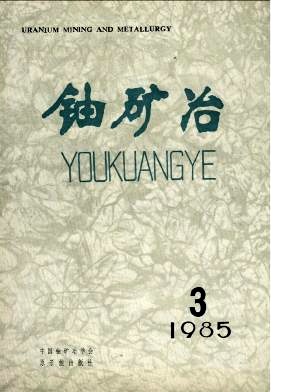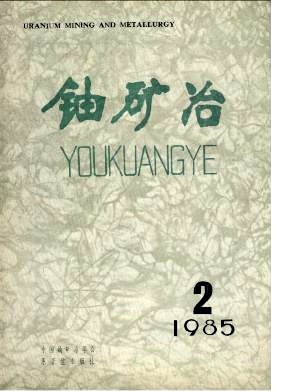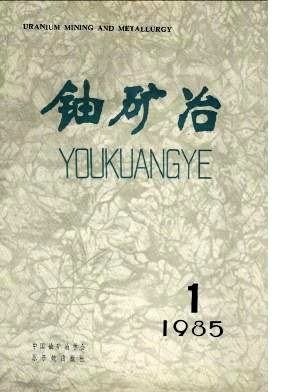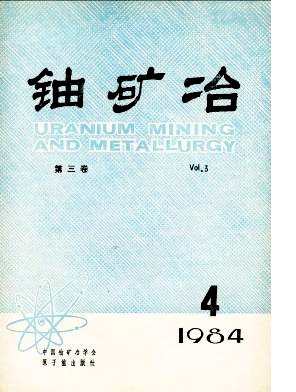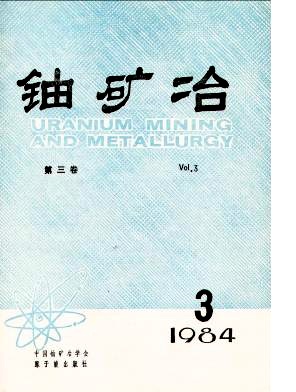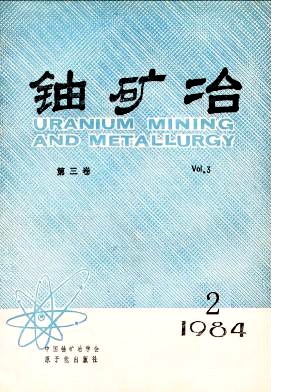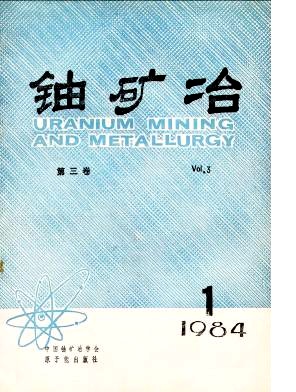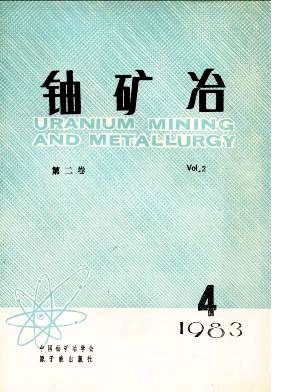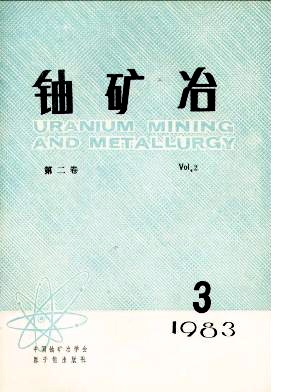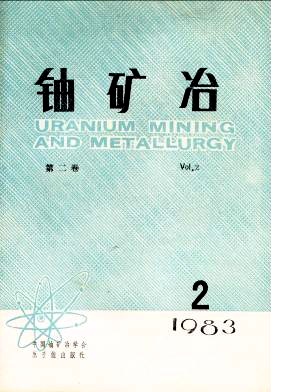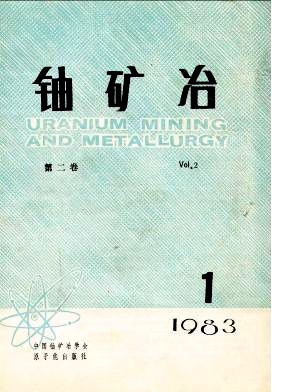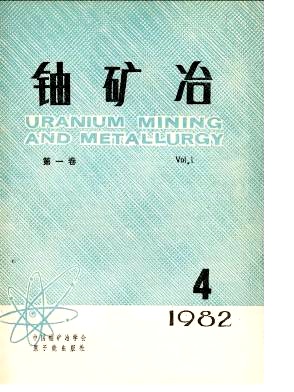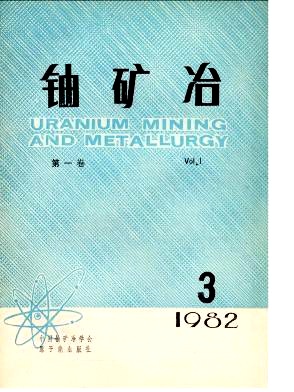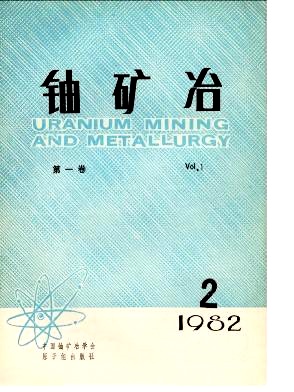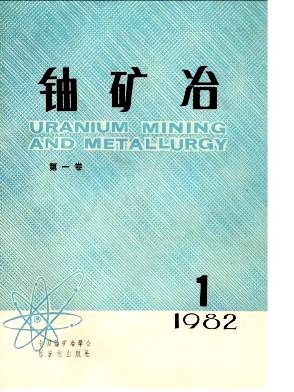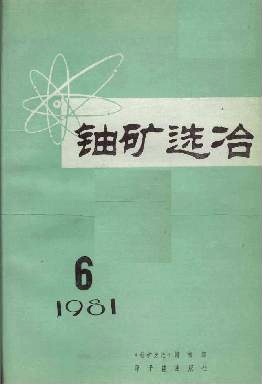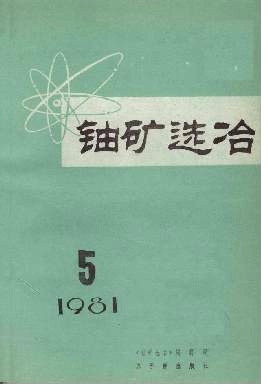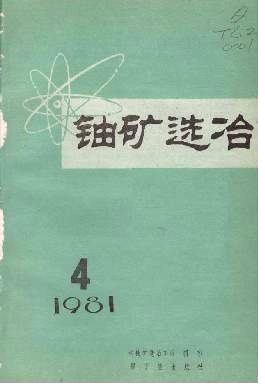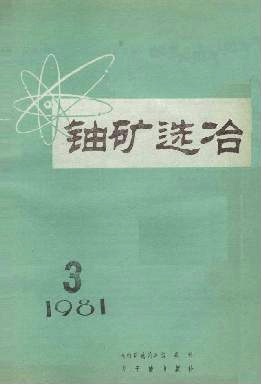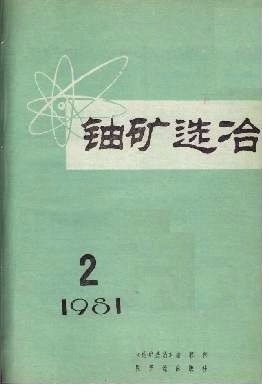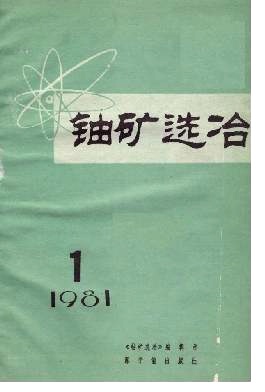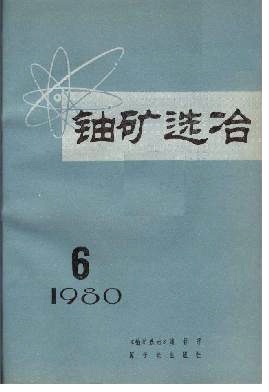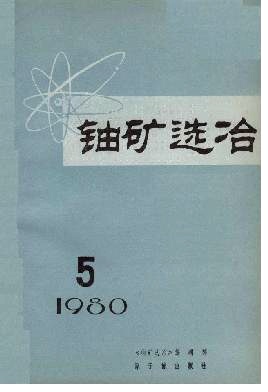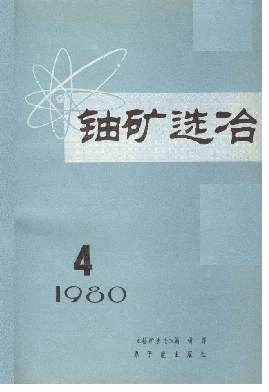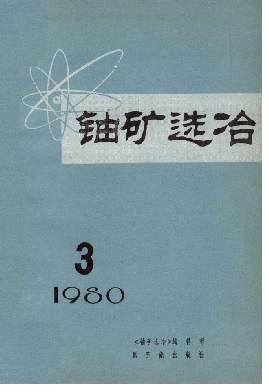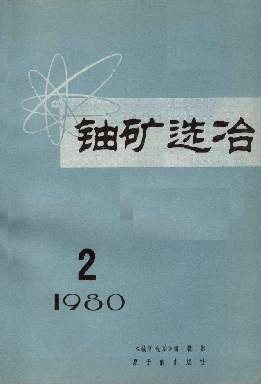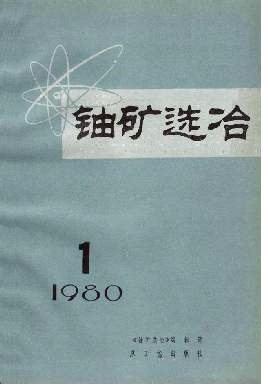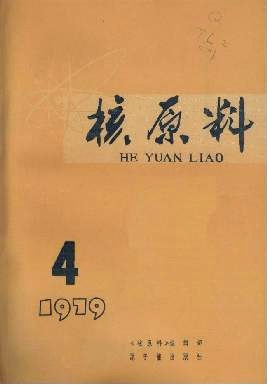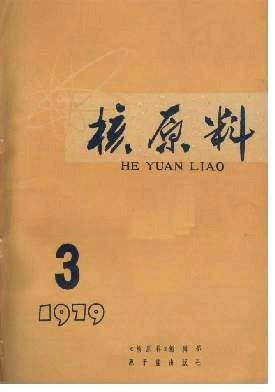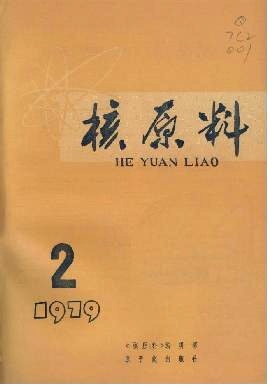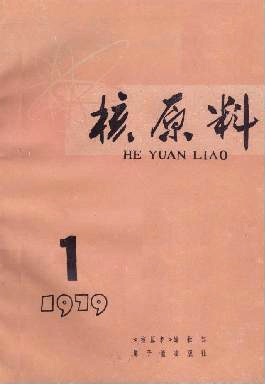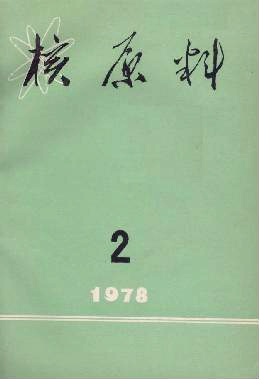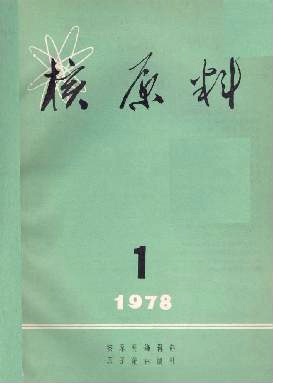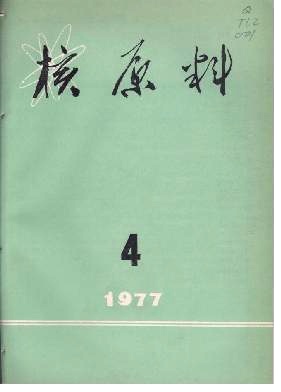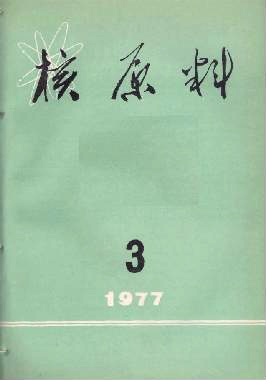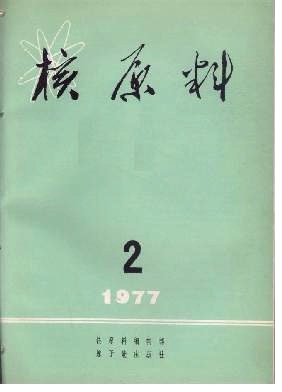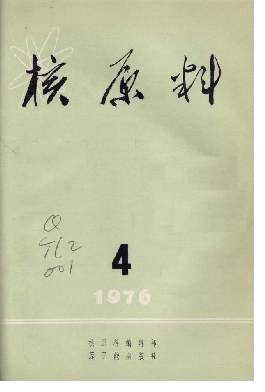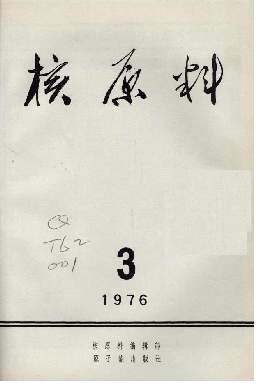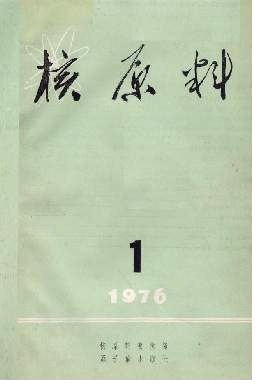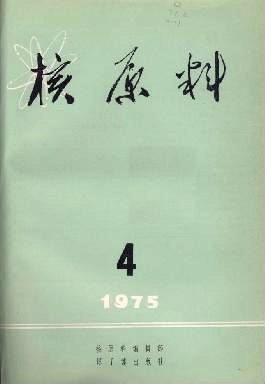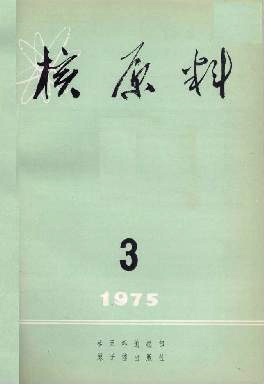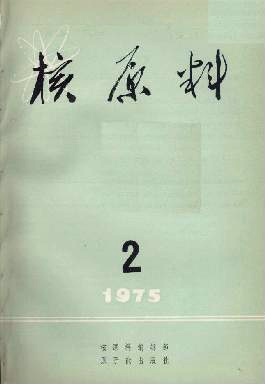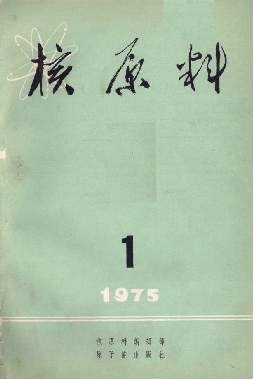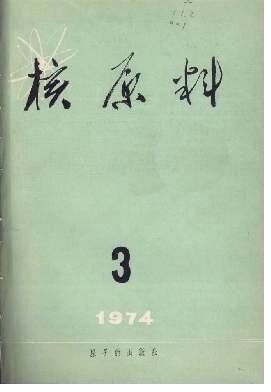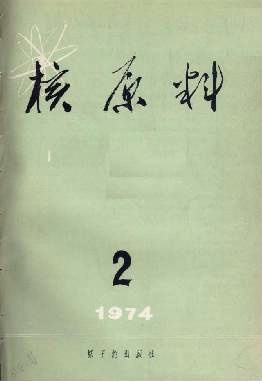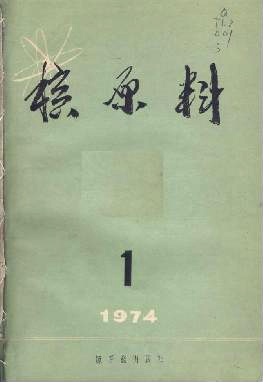
Tracking the information about your manuscript
Communicate with the editorial office
Query manuscript payment status Editorial OfficeCollecting, editing, reviewing and other affairs offices
Managing manuscripts
Managing author information and external review Expert Information Expert ReviewOnline Review
Online Communication with the Editorial Department
Introduction
Journal Editorial Board:Editorial Board of Uranium Mining and Metallurgy
Publication Period: Quarterly
Publication Place: Beijing
Language: Chinese
Supervisor: China National Nuclear Corporation
Organizer: Chinese Nuclear Society
Publisher: Editorial Board of Uranium Mining and Metallurgy
Editor in Chief: SU Xuebin
Tel: 8610-51674348, 51674124
E-mail: youkuangye@cnmstc.com
ISSN:1000-8063
CN:11-1969/TL
Postal Distribution Code: 82-745
Website: https://ykyi.cbpt.cnki.net

Performance and Mechanism of Uranium Adsorption from Seawater by Silver-Loaded Amidoxime-Functionalized Cycas Leaves Fibers
GUO Xinxin;ZHANG Hui;ZENG Tianze;GUO Ke'er;LING Yang;DING Dexin;Due to their abundant sources and biodegradability,plant fibers have become one of the most economical materials for seawater uranium extraction.However,the main challenge in seawater uranium extraction is that marine microorganisms attach,grow,and reproduce on the surface of adsorbent materials,leading to blockage of pores on the material surface and reduction in the number of adsorption sites.To develop an adsorbent material with both good adsorption performance and antibacterial properties,this study extracts plant fibers from cycas leaves,performs amidoxime-based modification through a two-step method of cyanylation and oximation to obtain amidoxime-functionalized cycas leaves fibers(AO-CLF),and then prepares silver-loaded amidoxime-functionalized cycas leaves fibers(Ag@AO-CLF) by in-situ reduction.The antibacterial performance of Ag@AO-CLF against Escherichia coli and Staphylococcus aureus was studied.The effects of factors such as pH,mass of the adsorbent,adsorption time,initial uranium concentration and interfering ions on its adsorption of U(Ⅵ) were investigated.The reaction kinetics and thermodynamic behavior of U(Ⅵ) adsorption were explored.Meanwhile,the reusability of the adsorbent was studied through adsorption-desorption cycle experiments,the adsorption effect of the adsorbent on U(Ⅵ) under complex interfering ions and simulated seawater conditions was evaluated,and its adsorption mechanism was studied by FT-IR,SEM-EDS,and XPS characterization methods.The results show that the adsorption capacity of 0.2 g/L Ag@AO-CLF in a solution with pH=5.0 and an initial uranium concentration of 5 mg/L is 24.6 mg/g for U(Ⅵ),and it still exhibits an adsorption efficiency of up to 98% for U(Ⅵ) in an environment containing multiple competing ions.In simulated seawater with pH=8.15 and a uranium concentration of 5 mg/L,the adsorption rate and adsorption capacity of this adsorbent are 98.4% and 23.67 mg/g,respectively.Meanwhile,its inhibition zone diameters against Escherichia coli and Staph ylococcus aureus are(12.8±0.2)mm、(11.0±0.5)mm,respectively,indicating good antibacterial performance.After 5 adsorption-desorption cycles,the removal rate and desorption rate of Ag@AO-CLF for U(Ⅵ) both remain above 90%,demonstrating good regeneration performance and strong stability,making it suitable for long-term applications in seawater uranium extraction.XPS results show that the adsorption of U(Ⅵ) by Ag@AO-CLF is mainly attributed to the C=O and N—O bonds in the amidoxime groups.
Integrated Geophysical-Geochemical Method and Mineral Prospecting Model for Uranium-Molybdenum Exploration in Shanghuofang Area, Inner Mongolia
WANG Shicheng;YU Bing;WANG Changdong;HAO Xiaofei;DONG Xiaoyu;LIN Tianfa;YU Honglong;The Guyuan-Hongshanzi area is a prominent uranium metallogenic belt in northern China, with the Hongshanzi pluton situated in its northern segment. In the eastern Shanghuofang area of the pluton, an integrated prospecting approach combining geological, geochemical, and geophysical methods was employed. By employing soil geochemistry and radon gas measurement techniques, geochemical anomalies were identified and the exploration area was effectively constrained. These anomalies were further analyzed in conjunction with induced polarization data, highlighting zones characterized by high resistivity and high chargeability, as well as the morphological features of high-precision ground magnetic anomalies. This integrated approach facilitated the interpretation of the structural framework in the Shanghuofang area. Induced polarization sounding provided insights into the spatial configuration of deep-seated anomalies, while controlled-source audio magnetotelluric(CSAMT) sounding delineated favorable zones for mineralization at greater depths, thereby enabling accurate spatial prediction of uranium-molybdenum ore bodies. Drilling validation confirmed the presence of multiple uranium-molybdenum ore bodies. The comprehensive geological, geochemical and geophysical prospecting process and prospecting model in Shanghuofang area were summarized and established, which provided the prospecting direction for uranium polymetallic ore exploration in this area.
Numerical Study on Groundwater Seepage Characteristics in Strata with Varying Dip Angles
PAN Jianguo;TAN Lihai;SHENG Jia;PENG Huaide;In the numerical study of groundwater seep characteristics in rock mass under different rock dip angles, the influence of seep field on internal defects such as holes and joints, the influence of seep field on rock mass stability, and the instability mechanism of rock mass under the coupling of seep field and ground stress field were seldom considered.This study employed discrete element software(PFC) to define fluid domains, simulating fluid-solid coupling evolution and rock mass failure behavior under coupled geostress and seepage fields. Macroscopic and microscopic analyses were conducted to investigate instability mechanisms. The results indicate that the coupling of high-stress fields and low-seepage fields can induce crack propagation in weak zones, such as crack tips, leading to rock mass failure. Compared to stress fields alone, coupling effects exhibit distinct failure patterns. Additionally, under low water pressure, seepage pressure can suppress tensile crack propagation at crack tips, primarily resulting in compressive failure zones. This research provides theoretical insights for understanding seepage behavior and assessing rock mass stability in complex engineering conditions.
Cumulative Damage of the Waiting Mining Body in the Two-step Mining Area of a Copper-Gold Ore Body in a Mine
CHEN Zhiqiang;ZHANG Yujian;ZHAO Yibo;In response to the cumulative damage of rock mass during the two-step mining of copper-gold ore body using the sub-level stoping with delayed backfill method in a mine, acoustic wave detection technology was used to collect acoustic wave data of the ore body before blasting and during the blasting and mining process, and the ore body integrity coefficient results were combined with FLAC3D software to conduct numerical simulation analysis of the mining process. The results show that the ore body integrity is at level Ⅲ before blasting and mining. After 3 to 4 rounds of blasting and mining operations, the cumulative damage degree of the ore body within a range of 4 rows(8.8 m) from the blast source is relatively large, and the integrity changes from level Ⅲ to level Ⅴ. The stress safety factors of the front and rear areas of the stope are both greater than 1.5, indicating that the roof and the filling body are overall stable. After the mining of the rear area of the stope, the plastic deformation areas of the roof and floor of the voids, as well as the surrounding rock and side wall filling body, significantly expand. It is recommended to backfill as soon as possible after mining to reduce the risk of collapse of the surrounding rock and the filling body.
Corrosion of Calcite under Different CO2 Partial Pressures
XIE Yufan;ZHANG Hui;LI Feng;ZENG Tianze;CAO Qian;DING Dexin;Calcite is an important carbonate mineral in sandstone-type uranium deposits,and its corrosion-precipitation behavior directly affects the permeability of the deposits.To gain a deeper understanding of the mechanisms behind permeability decline during "CO_2+O2" in-situ leaching of sandstone-type uranium deposits,the stirred leaching experiments using calcite in a high-pressure reactor under varying CO2 partial pressures was conducted.The results indicate that higher CO2 partial pressures lead to lower solution pH and higher HCO3~- concentrations,significantly enhancing calcite corrosion.However,the Ca2+ released during corrosion can trigger secondary calcite precipitation.Differential corrosion was observed on the calcite surface,forming distinct corrosion pits.Additionally,the pore structure of calcite underwent notable changes,characterized by the disappearance of micropores,a reduction in pore volume,and an increase in average pore size.Based on the above findings,a dynamic control strategy of "high-pressure unclogging followed by low-pressure maintenance" was proposed for in-situ leaching operations,providing both theoretical foundation and engineering guidance for optimizing the "CO_2+O2" in-situ uranium leaching process.
CFD-DEM Coupled Simulation of Pneumatic Conveying Pipelines for Uranium Dioxide Particles
ZHOU Wujiang;DENG Jian;LEI Jieheng;LEI Zeyong;YANG Wenxue;To address pipeline blockage issues in the negative-pressure pneumatic conveying of uranium dioxide at a uranium company, this study employed a combined approach of CFD-DEM coupling simulation and field experiments. By examining particle flow patterns, gas-phase pressure distribution, and system pressure drop, the underlying mechanism of pipeline blockage was elucidated. The validity of the simulation model was confirmed through comparative analysis of field measurements and numerical results. The findings demonstrate that increasing the elbow curvature radius from 200 mm to 500 mm and the bend diameter ratio from 2.50 to 6.25 significantly reduced local pressure losses during conveying. As a result, particle flow stability improved, with the peak gas-phase pressure dropping to 27.2 kPa and the overall system pressure drop decreasing markedly, thereby restoring normal operation of the power equipment. This study verifies the reliability of the CFD-DEM model for optimizing the pneumatic conveying system of uranium dioxide particles, offering both theoretical support and practical guidance for achieving efficient and stable transport.
[Downloads: 0 ] [Citations: 0 ] [Reads: 0 ] HTML PDF Cite this article
Selection of Uranium Mine Well Development Plan Based on Fuzzy Comprehensive Evaluation Method
LI Congfei;The selection of mine development plans is a complex process involving multiple factors and indicators. In order to reduce the influence of subjective judgment on the selection of mine development plans, taking a certain uranium mine well as the research object, a fuzzy comprehensive evaluation model was established based on the theory of fuzzy mathematics, the fuzzy weights of 10 influencing factors were determined, and the influence degree of the development plan was quantified.Based on the fuzzy judgment weight matrix and the relative membership degree matrix, and in accordance with the principle of fuzzy mathematics comprehensive evaluation, the optimal development method is determined from the initial development schemes of fuzzy clustering. Through fuzzy comprehensive evaluation, the optimal main and auxiliary shaft development schemes are determined as the vertical shaft and vertical shaft development scheme. According to the different hoisting methods of the mines, a technical and economic comparison was conducted on the two proposed schemes. The comparison results recommend that the centralized hoisting schemes of the two mines be adopted as the mine development schemes.
[Downloads: 0 ] [Citations: 0 ] [Reads: 0 ] HTML PDF Cite this article
Bubble Behavior and Flow Pattern Evolution of Oxygen Injection in In-situ Leaching Uranium——A Case Study of Static Mixers
DANG Junjie;CAO Mingqian;WANG Ya'an;YUAN Yuan;In the oxygen injection process of “CO_2+O2” in-situ leaching uranium, oxygen is prone to bubble coalescence and flow regime deterioration during long distance transportation, which in turn induces gas blockage, resulting in intermittent liquid injection, and decrease in leaching efficiency. To reveal the mechanism by which bubble size evolution regulates flow stability, this study designed a visualization experimental system for static mixers used in in-situ leaching uranium. Particle shadow velocimetry(PSV) was employed in combination with multi-stage image processing techniques—including Gaussian filtering, adaptive threshold segmentation, and morphological reconstruction. To achieve high resolution in-situ observation of micro bubble size, distribution, and dynamic behavior. The results show that as oxygen concentration increase from 15 mg/L to 700 mg/L, the median bubble diameter(d50) rise from 528 μm to 823 μm. Conversely,increasing water flow rate from 0.5 m3/h to 2.0 m3/h, d50 reduce from 945 μm to 412 μm, indicating significantly enhance dispersion capability. With rising oxygen concentration, the flow patterns evolve sequentially from fog flow, through bubble flow and transition flow, to slug flow. In the slug flow regime, periodic bubble collapse at the pipe top lead to a field gas blockage frequency of 3.2±0.8 times per week. This study demonstrates that the proposed image processing method provides highly reliable data for microbubble size distribution, coalescence frequency, and flow pattern identification, offering a solid foundation for process optimization and control of oxygen injection in in-situ leaching uranium.
[Downloads: 38 ] [Citations: 0 ] [Reads: 0 ] HTML PDF Cite this article
Research Progress on the Blockage of In-situ Leaching Uranium Induced by Clay Minerals and Pyrite
ZHAO Xuerui;LIU Zhenzhong;LI Chunguang;XU Ying;DUAN Xianzhe;QUE Weimin;TANG Zhenping;In-situ leaching(ISL) of uranium, a core technology in China's uranium mining, faces significant challenges due to pore clogging caused by clay minerals and pyrite, which severely restricts leaching efficiency and production capacity. This paper systematically reviews the causes and mechanisms of clogging phenomena in acid leaching,alkaline leaching, and "CO2+O2" neutral leaching processes. It reveals that clay minerals induce pore blockage through physicochemical interactions such as swelling, ion exchange, and chemical transformation, while pyrite oxidation generates sulfate and iron ions, leading to permeability reduction via mineral precipitation and colloidal adsorption.Current unblocking technologies primarily employ inhibitors to suppress pyrite oxidation, chelating agents to immobilize iron-containing precipitates, and swelling suppressants to mitigate clay mineral expansion. However,challenges remain, including lack of specificity, limited environmental compatibility, and insufficient long-term stability. Future research should focus on elucidating the synergistic mechanisms of clay-pyrite interactions, developing intelligent unblocking materials with targeted functionality, and establishing ecological risk assessment frameworks.These advancements aim to drive innovation in green and efficient unblocking technologies, providing theoretical and technical support for China's large-scale uranium base construction and sustainable nuclear energy development.
[Downloads: 41 ] [Citations: 0 ] [Reads: 0 ] HTML PDF Cite this article
Selection of Construction Plan for a Certain Associated Radioactive Solid Waste Disposal Facility
JIN Wei;DONG Chunming;WANG Libin;China's associated radioactive waste residues are wide-ranging in origin, diverse in type, and large in quantity, which has begun to constrain the healthy development of the associated radioactive mineral industry. There is an urgent need to build scientifically standardized repositories for long-term disposal. On the basis of reviewing domestic and international disposal approaches for associated radioactive solid waste, and by analyzing the geological conditions, storage capacity, investment costs, safety assurance, construction conditions, and operation and maintenance of a specific disposal repository as well as the suitability of different disposal methods, Then proposing a repository construction scheme with high feasibility.
[Downloads: 21 ] [Citations: 0 ] [Reads: 0 ] HTML PDF Cite this article
ON THE THEORY OF AXIAL VARIATION AND BASIC RULES OF DEFORMATION AND FRACTURE OF ROCKS SURROUNDING UNDERGROUND EXCAVATIONS
Yu Xuefu (Beijing University of Iron and Steel Technology)At present, theories applied to explain stability of underground excavation have been undergoing a progress from the analogism of empirical engineering toward the scientific reasoning.(下转第7页)The significant marking of the progress proceeding from the recognization of the stress of virgin rock as an important influential factor,is the application of concrete analyses to the stress of rock surrounding the underground excavation and the modes of their deformation and destruction that are beyond the mechanical application of conventional rules for surface structures to approach underground problems, and hence entering into a new stage that scientific theories are being used to explain modes of stability of underground excavation, In this paper, the theory of axial variation and basic rules of deformation and destruction of surrounding rocks are emphatically discussed. Besides, conventional me thods for stabilization and maintenance of excavations and development of ground pressures are also described briefly.
Treatment technology of low concentration uranium-bearing wastewater and its research progress
WEI Guang-zhi,XU Le-chang(Beijing Research Institute of Chemical Engineering and Metallurgy, CNNC,Beijing 101149,China)With growth of the discharged uraniumbearing wastewater capacity,a low cost and effective treatment technology is required to avoid transferring and diffusing of the radioactive nuclides.On the basis of analyses of the source and characteristics of the low-concentration uranium-bearing wastewater,the conventional treatment technologies,such as,flocculating settling,ion exchange,concentration,adsorption,and some innovatory technologies,such as,membrane,microorganism,phytoremediation and zero-valent iron technology are introduced.
[Downloads: 2,715 ] [Citations: 237 ] [Reads: 19 ] HTML PDF Cite this article
INTRODUCTION TO COMMON SOFTWARE PRODUCTS MODELING GROUNDWATER
XU Le chang(Research Institute of Uranium Mining, CNNC, Hengyang 421001, China)Groundwater Modeling is playing an increasingly important role in researching into groundwater.Now hundreds of software products modeling groundwater are available.This paper introduces main functions and features of some common software products,such as GMS,Visual MODFLOW,Visual Groundwater,PHREEQC,HST3D,TNTmips,and moreover,presents steps in modeling protocol.
DETERMINATION OF RADON EDUCTION RATE AND EXPLORATION ON ITS INFLUENCE FACTORS
LI Ren jie [WT5”BZ][ST5”BZ](Jinyuan Uranium Corporation, CNNC, Beijing 100822, China)Methods of determination of radon eduction rate in uranium mining and hydrome tallurgy system are discribed.Its influence factors such as precipitation,air pressure,air temperature,ground temperature,and humidity etc.are explored.
Research advances in treatment technology of radioactive wastewater
LI Xiao-yan,ZHANG Ye(Faculty of Civil and Environmental Engineering,East China Institute of Technology,Fuzhou 344000,China)Traditional treatment technologies on radioactive wastewater such as flocculating sedimentation,ion exchange,evaporation concentration and adsorption method at home and abroad are reviewed,and the latest research progress such as membrane method,biological treatment,magnetic-molecules method,inert curing method and permeable reactive(zero-valent iron) barriers technology are introduced.
Treatment technology of low concentration uranium-bearing wastewater and its research progress
WEI Guang-zhi,XU Le-chang(Beijing Research Institute of Chemical Engineering and Metallurgy, CNNC,Beijing 101149,China)With growth of the discharged uraniumbearing wastewater capacity,a low cost and effective treatment technology is required to avoid transferring and diffusing of the radioactive nuclides.On the basis of analyses of the source and characteristics of the low-concentration uranium-bearing wastewater,the conventional treatment technologies,such as,flocculating settling,ion exchange,concentration,adsorption,and some innovatory technologies,such as,membrane,microorganism,phytoremediation and zero-valent iron technology are introduced.
[Downloads: 2,715 ] [Citations: 237 ] [Reads: 19 ] HTML PDF Cite this article
A summary of studies on mine wastewater treatment
MA Yao,HU Bao-qun,SUN Zhan-xue(East China Institute of Technology,Fuzhou 344000,China)The composition of mine wastewater is complicated and is harmful to the environment.The mine wastewater treatment methods include mainly neutralization,constructed wetland and microorganism methods.The three methods are summarized,with focus on the microorganism method.The mechanisms,characteristics and influencing factors of the sulfate reducing bacteria and the iron oxidizing bacteria are discribed in detail.The treatment methods of uranium mine wastewater are presented.
INTRODUCTION TO COMMON SOFTWARE PRODUCTS MODELING GROUNDWATER
XU Le chang(Research Institute of Uranium Mining, CNNC, Hengyang 421001, China)Groundwater Modeling is playing an increasingly important role in researching into groundwater.Now hundreds of software products modeling groundwater are available.This paper introduces main functions and features of some common software products,such as GMS,Visual MODFLOW,Visual Groundwater,PHREEQC,HST3D,TNTmips,and moreover,presents steps in modeling protocol.
Research advances in treatment technology of radioactive wastewater
LI Xiao-yan,ZHANG Ye(Faculty of Civil and Environmental Engineering,East China Institute of Technology,Fuzhou 344000,China)Traditional treatment technologies on radioactive wastewater such as flocculating sedimentation,ion exchange,evaporation concentration and adsorption method at home and abroad are reviewed,and the latest research progress such as membrane method,biological treatment,magnetic-molecules method,inert curing method and permeable reactive(zero-valent iron) barriers technology are introduced.
Research advances in adsorption of heavy metals by algae
ZHANG Yong-liang1,ZHANG Hao-jiang2,XIE Shui-bo1,TANG Dong-shan1,CHEN Shan1,WANG Shui-yun1(1.Pollution Control and Resource Technology Key Laboratory of Hunan Province,University of South China,Hengyang 421001,China;2.School of Civil Engineering,Hunan University,Changsha 410082,China)Algae has a strong ability to enrich heavy metal ions.It can be used as biological adsorbent to remove and recover the heavy metals in industrial wastewater.The basic features of algae,the adsorption mechanisms and ion exchange of the toxic heavy metals are introduced.Key factors of influencing algae adsorption,such as pH value,adsorption time,coexistence ions and pretreatment are explained.Thermodynamics and dynamics of algae adsorption are also discussed.The research directions are presented.
Links
Page Views
Page visits today: 549
